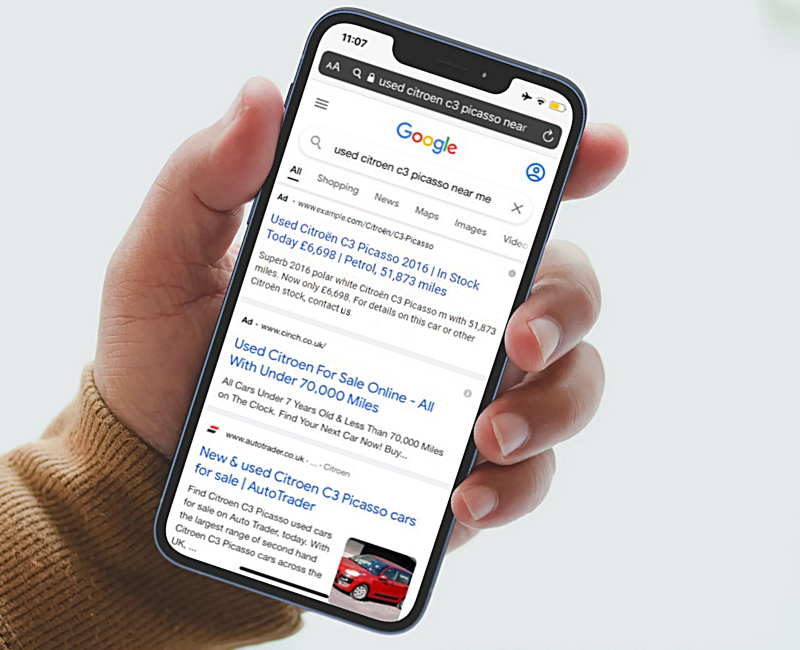Google Advertising for Automotive – Pay Per Click
Author: Neil Breakwell - Digital Marketing Specialist
Google offers a range of pay-per-click (PPC) opportunities to car dealers, with the main options being:
- Google Search Advertising
- Google Display Advertising
- Vehicle feed-based Search ads for Google
As a car dealer, it is important to select the appropriate product (s) to meet your business requirements and align this with any search engine optimisation (SEO) activities that you are doing.
Below is an overview of the pros and cons of each of these options and some pointers on what to consider before choosing where to spend your hard-earned advertising budget.
Google Pay Per Click Search Advertising
PPC is a great way to drive customers to your digital storefront and capitalise on these users that are typing certain keywords into search engines when relevant to your business.
Google search ads appear at the top and bottom of Google search results pages and compete with the organic listings for the user’s attention.
One of the main benefits of Google search ads over display is that your ads appear when people are searching for keywords related to your business, rather than just browsing.
Example of Google Search ad
Let’s show you an example using our very own business model. Here at Autoweb Design, our main focus is website design for car dealers, so we’ll show you how and when our ads are likely to appear.
Here, we have searched for a keyword or phrase related to Autoweb Design, and a keyword we have specified we want our ad to appear for (this can be done when creating a campaign, which ensures your ad doesn’t show for irrelevant terms).
As you can see here, our ad shows because we have specified that our ad should show for this search term. The maximum CPC (cost-per-click) we are willing to pay is also high enough to ensure the ad shows above competitors who are also targeting the same keyword or phrase.

You will have likely seen these search ads appear when you have previously searched for something on Google, whether for local businesses or when you were looking to buy something online.
How Google search ads work
Google search ads work by targeting specific keywords in your campaigns, which are essentially a list of words and phrases that people are likely to be searching that are relevant to your offering.
You can target these users by location, time of day, day of the week and type of device that the user is searching on. You can also target, to some degree, by demographic.
There is a hierarchical structure to how search ads are built:
Campaign – this is the top level ‘container’ which will hold your individual ads. A campaign should be exactly that – if you have a specific event for example, this is your campaign. If you are targeting New Mazda for example, this is your campaign.
Ad Group – Ad groups sit inside campaigns, so in this instance, you will have New Mazda as your campaign, and then New Mazda 3 will be your ad group.
Ads & Extensions – Ads will be created for each ad group, so the ad itself is relevant to the target keywords you specify for that ad group. If we use the New Mazda 3 example, your ads could mention Mazda offers or Mazda test drive call to action.
Keywords – Your keywords will be specific to each ad group, so you can target down as narrow as you need to, or as broad as you need to go.
In simplistic terms, Google search campaigns are created via the Google Ads interface, and once created, the campaign ads compete for traffic with other advertisers via a real time auction.
The more you are prepared to pay, the more often your ads will show and the more likely you are to grab that premium ad spot when competing with other businesses for your target keywords.
What to consider before building Google search ads
It’s important to understand that whilst Google wants to make maximum money from these ads, they also have to offer a good user experience, which is where something called quality score comes in.
Quality score, in simple terms, is an assessment of how relevant your ad and landing page experience are to the user.
A good quality score acts like a booster, giving you improved prominence for your money, whereas a poor quality score is like a penalty, requiring you to pay more for visibility. Quality score is therefore one of the most important aspects of running a successful search PPC campaign.
There are many ways to improve quality score, some relatively simple and others very nuanced. One of the simplest methods is to ensure that you use a good range of ad extensions.
Ad extensions are additional snippets of information that increase the size and relevance of your ad. Extensions include:
Call extensions - allowing the searcher to call you by clicking on the ad using a mobile device
Location extensions - providing your business address or distance
Call out extensions - snippets of text like ‘book a test drive online’
Sitelink extensions - allowing people to be taken directly to specific pages on your website
Structured snippets - headed text that give details of what you offer like car makes, models or types.
There are other types of extensions to consider, all of which will impact your campaigns in different ways.
The importance of quality score cannot be overstated, it is worth researching and understanding this subject thoroughly before embarking on Google search campaigns if you plan to manage your own PPC activity.
Feed-Based Pay Per Click Search Ads for Google
For used car sales, search ads have practical limitations. Creating a specific ad for every single used vehicle in your inventory and keeping it up to date would take more time than most of us have.
Fortunately, there are solutions on the market, perfect for advertising specific used vehicles, like our AutoAds product.
AutoAds automatically generates vehicle specific ads for Google search campaigns, which takes specifications from your product feed like make, model, price, year and mileage.
The ads are updated from your feed daily, so they are always relevant to the used vehicles that you have available, rather than having to add and remove stock as it rotates.
As an example, someone may know they want a 2016 Citroen C3 Picasso in White and, if you have one in your inventory, your vehicle specific ad (from AutoAds) will show.

Because this vehicle matches the search intent and your ad is more relevant to the user, it is much more likely to capture the attention of the user than ‘used Citroen C3 Picasso’ would.
AutoAds uses all the same targeting that is available for regular search ads, and because the ads are so specific to the used vehicles you have on offer, can also help increase your Google account quality score, and we know how crucial that is!
Google Pay Per Click Display Advertising
Google also provides advertisers with the opportunity to reach potential customers when they are engaged in other activities on the internet i.e. not searching for your products and services, but browsing partner websites.
The Google Display Network (GDN) is a group of more than 2 million websites, videos, and apps where your Google ads can appear.
What is a display ad
A display ad is a visual static ad or a rotating GIF style ad that appears as a banner on the side, top or within the content of a partner site.

The Google Display Network allows you to set what types of websites your ad is shown on and who to, based on features of your preferred audience, such as their interests, age, or gender.
Using this information, Google places your ads on sites relevant to your business and shows ads to users who match the Google Ads audience as they browse non relevant websites.
You can also use keywords to target an audience further, the keywords can relate to the websites that are being viewed or the searcher’s browsing history.
Targeting options
There are different targeting options you can use to reach the right audience using display ads.
There are different targeting options you can use to reach the right audience using display ads.
In-market audience
One of the best options given to dealers is to target in-market audiences. An in-market audience refers to anyone who has actively been searching for intent driven search terms previously, meaning they aren’t just browsing, but they are actively looking for information on certain products or services such as pricing.
Let’s say a user is in the market for a new car has viewed a particular car model on a manufacturer’s website. Afterwards, this could prompt your display ads for the same model to be shown to them as they continue to browse other websites that have ads applied.
Affinity audience
Affinity audiences allow you to reach audiences based on their habits and interests, rather than them being actively ready to buy. This allows you to build brand awareness so they know who you are when the time comes for them to purchase a new car.
Types of display ads
Besides having great targeting options, Google also has various ad formats, including responsive display ads, uploaded ads, video ads and Gmail ads.
Responsive display ads are partially automated, they are created using the Google Ads interface. You add your images, logos and text, and Google will create ads in various sizes, optimising them for the best results. Google will change some elements of the ad like colours to work best with the page that the ad is appearing on. These ads are simple to make, but are quite restrictive regarding image options, and the amount of text you can use.
You can also upload image ads that you have created yourself, but these must be made to the specifications required to fit the various ad slots available on the GDN.
The advantage of this type of ad is that you control the creative and narrative 100%. The downside is that creating them requires more time, effort and you will need design skills or access to designers.
There are also various video ad formats that show on YouTube and across partner sites. Gmail ads are expandable ads that show on the top tabs of people’s inboxes if you’d rather go down this route.
Display ads generally don’t convert as well as search ads for car dealers, simply because the audience does not have the same level of intent.
However, they are great for building brand awareness campaigns, and for putting your current offers in front of people. They are a powerful tool for the automotive advertiser.
Google PPC Advertising With Autoweb Design
If you would like to learn more about Google PPC Advertising for your dealership, please get in touch. We have a team of marketing experts waiting to help you achieve your business goals.

